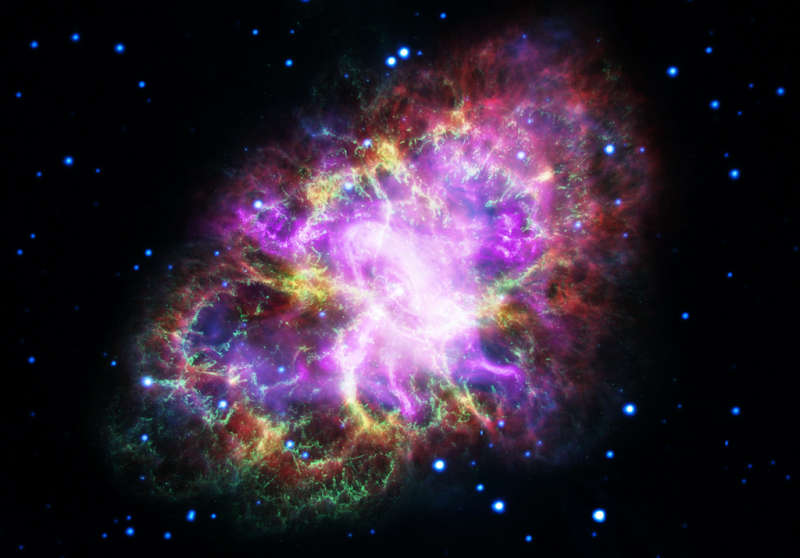Credit & Copyright: NASA,
ESA,
G. Dubner
(IAFE, CONICET-University of Buenos Aires) et al.;
A. Loll et al.; T. Temim et al.; F. Seward et al.; VLA/NRAO/AUI/NSF; Chandra/CXC;
Spitzer/JPL-Caltech; XMM-Newton/ESA; Hubble/STScI
Explanation:
The Crab Nebula is cataloged as M1, the first object on
Charles
Messier's famous list of things which are not comets.
In fact, the Crab
is now known to be a
supernova
remnant, expanding debris from massive star's death explosion,
witnessed on planet Earth in 1054 AD.
This
brave new image offers a 21st century
view of the Crab Nebula by presenting image data from across the
electromagnetic
spectrum as wavelengths of visible light.
From space,
Chandra (X-ray)
XMM-Newton (ultraviolet),
Hubble (visible), and
Spitzer (infrared),
data are in purple, blue, green, and yellow hues.
From the ground,
Very Large Array
radio wavelength data is in shown in red.
One of the most exotic objects known to modern astronomers,
the Crab Pulsar,
a neutron star spinning 30 times a second,
is the bright spot near picture center.
Like a cosmic dynamo,
this collapsed remnant of the stellar core
powers the Crab's emission across the electromagnetic spectrum.
Spanning about 12 light-years, the Crab Nebula is
6,500 light-years away in the constellation
Taurus.
A. Loll et al.; T. Temim et al.; F. Seward et al.; VLA/NRAO/AUI/NSF; Chandra/CXC;
Spitzer/JPL-Caltech; XMM-Newton/ESA; Hubble/STScI
1999 2000 2001 2002 2003 2004 2005 2006 2007 2008 2009 2010 2011 2012 2013 2014 2015 2016 2017 2018 2019 2020 2021 2022 2023 2024 2025 |
Январь Февраль Март Апрель Май Июнь Июль Август Сентябрь Октябрь Ноябрь Декабрь |
NASA Web Site Statements, Warnings, and Disclaimers
NASA Official: Jay Norris. Specific rights apply.
A service of: LHEA at NASA / GSFC
& Michigan Tech. U.
|
Публикации с ключевыми словами:
M 1 - Crab Nebula - Крабовидная туманность
Публикации со словами: M 1 - Crab Nebula - Крабовидная туманность | |
См. также:
Все публикации на ту же тему >> | |
